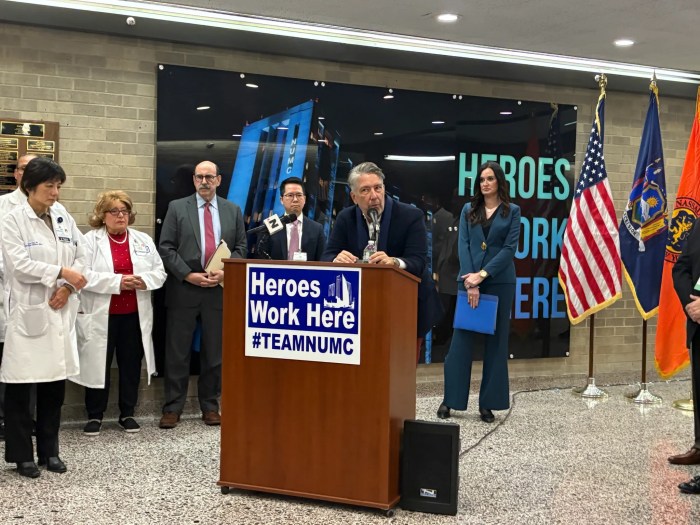
FLUSHED
The vast majority of wastewater disposal systems in Suffolk are merely the basic cesspool system, which, in many cases, is just a ring of concrete cinder blocks forming an underground waste pit. But since 1997 another system has been used for larger, multi-family dwellings and commercial properties.
Manufactured by Williamsport, Penn.-based Cromaglass Corporation, the company’s wastewater treatment systems have been installed across the globe, from Baghdad to Lake Tahoe, for nearly 50 years. They are, in essence, onsite, mini-sewage treatment facilities, also known as “package” treatment plants, that typically handle flows ranging from 1,000 to 15,000 gallons of wastewater per day, or the equivalent of three to 50 full-sized single-family residences.
Cromaglass technology helped open parts of unsewered Suffolk to development, providing prospective builders with a solution for large-dwelling construction projects that could not otherwise meet the EPA’s nitrogen removal requirements and effluent standards.
There are between 32 and 40 such systems now in use throughout Suffolk, according to the health department and the company, respectively. They service about 2,000 residents of senior living facilities, hotels, aprtment and condominium complexes, says the company.
Until December 2011, Cromaglass was the only such system permitted for new developments. Now, Boston, Mass.-based Lombardo Associates’ Nitrex and Walton, Ken.-based Purestream’s BESST (Biological Engineered Single Sludge Treatment) systems can also be used.
An ongoing study by the county health department that will include an assessment of operation and cost-benefit analysis, to be completed next month, may open the door to other systems as well, and in addition, will evaluate whether any approved systems are appropriate for single-family homes.
The Nitrex system, touts the health department, has the capability of reducing nitrogen to the range of 2 to 3 milligrams per liter of wastewater discharged, a figure not lost on McAllister, who for years has been calling for more choices, better technology and demanding higher-grade effluent.
McAllister wants lawmakers and the county health department to de-certify Cromaglass, devise protocol for it and other onsite septic-cesspool systems’ replacement—possibly as incentives or at time of property transfer—and mandate all new developments to solely use the most efficient systems.
McAllister bases his demands on EPA discharge monitoring reports he obtained through a Freedom of Information Law request that shows, out of 27 Cromaglass systems installed in Suffolk, for 2008, 2009 and 2010, “Two out of every three were failing. Failing means they were not meeting the permit discharge standards, which is for drinking water protection,” he says.
The Press verified the documents through online, publicly accessible EPA databases.
“Why does Suffolk County still provide the ability to select from the list when there’s a significant disparity on performance?” he asks. “I’ll cut right to the chase: Nitrex, three parts. Cromaglass, two out of three can’t even get down to 10 parts. And some of these are through the roof—discharges of 40, 50 milligrams.”
Other environmentalists are equally critical of the Cromaglass system.
“They’re just not effective at all,” says Amper. “We need new technology; we need less density.”
Cromaglass’ Suffolk County representatives Lou Kircher and son Jeff, both self-described environmentalists themselves, defend the system, saying it is an effective, efficient process that provides an environmentally responsible alternative to cesspools and septic systems for future development in Suffolk. Although the systems aren’t 100 percent perfect, they say, they’re pretty close—as long as they’re properly maintained and operated.
“Operator neglect and owner indifference” are the biggest challenges to the system’s performance, says Jeff. “Every system is only as good as the operator.”
Jeff, whose background is in biochemistry and microbiology, explains that he and his father install the systems, but it’s up to the operators and property owners to maintain them. The Suffolk health department’s Office of Wastewater Management oversees and enforces Cromaglass and other sewage treatment plants’ compliance to nitrogen standards, confirms a health department spokesperson—with “enhanced (quarterly) inspection and monitoring, significant fines for violations, and requirements for reserve funding for upgrades.”
Jeff says the health department has historically lacked manpower, the inspectors were worn thin and overwhelmed. [According to the health department, three inspectors are responsible for all 193 sewage treatment plants, including Cromaglass, and 80 pump stations, in Suffolk.]
“The county is understaffed and has not been able to be diligent enough, but they have now become much more stringent in supervision of the plants,” Jeff says. “And in addition, Cromaglass, actually, has been contracted to do additional inspections.”
The Cromaglass system utilizes a complex process, and the EPA documents also show that the systems can achieve nitrogen discharges as low as 1, 2, 3 and 4 milligrams per liter.
In a nutshell: Post-flush, users’ waste and wastewater flow into a well before entering the Cromaglass system, where throughout a six-hour cycle that involves both aerobic and anaerobic bacteria treatment, aerobic bacteria break down the carbon and hydrogen from the wastewater, leaving nitrogen, and anaerobic bacteria consume the nitrogen. From there, the waste travels to a digester, where any suspended solids settle out. The remaining liquid, also called grey water, then flows into a sludge tank and is then released into leaching fields, where the treated effluent enters the ground.
In addition to all this, the system has odor vacuums to combat fumes or foul smells, and features complete redundancy—meaning that if one particular aspect of the process fails, others can back it up.
The Suffolk health department stands behind Cromaglass, too, telling the Press in a written statement regarding the EPA documents:
“While there were some startup problems in the initial Cromaglass systems, performance of these systems in Suffolk County is now very good,” says a spokeswoman. “These systems are operating better than other full-size wastewater treatment plants in Suffolk County, and have significantly reduced nitrogen loading to groundwater and surface waters as compared with the alternative of onsite septic tanks and leaching pools.”
Despite the high praises from the health department, however, some lawmakers aren’t fans.
Legis. Ed Romaine (R-Center Moriches) has “grave concerns” about the Cromaglass system, and suggests the health department irreversibly damaged relations with the legislature over the issue.
“I raised a ton of questions back in July, and they blew me off,” says Romaine, who suspects the health department has done an about-face and the report expected next month will show that the agency is now more critical of Cromaglass. “This is a department that gave us a great deal of difficulty in approving other systems.”
He believes that in addition to phasing out Cromaglass and the new push to sewer the county, there should also be incentives for homeowners with the worst polluting systems—pre-1972 cesspools—to replace their old systems with often cost-prohibitive, more advanced wastewater treatment alternatives. Yet it may already be too late, he says, when factoring in underground nitrogen and ammonia plumes oozing into the ground today that will not reach the bays and aquifers for 20 years or more.
“It’s sobering when you think about [it],” Romaine says. “This is a problem that may defy solution. Even if we make some solutions, even band-aid solutions, they may not protect the bays or the drinking water to allow both to be enjoyed a generation from now.”


























